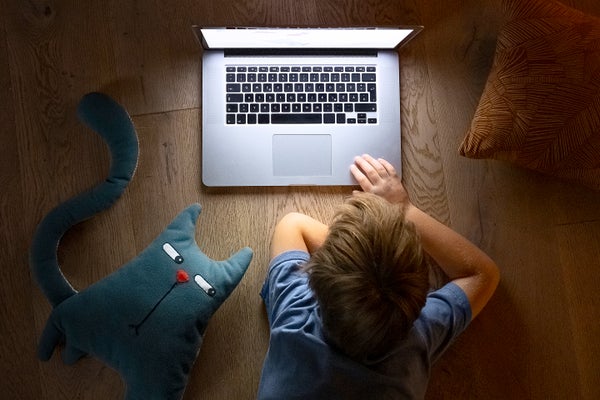
Even Four-Year Olds Instinctively Fact-Check for Misinformation
www.scientificamerican.com
April 1, 20254 min readFour-Year Olds Respond to Misinformation by Exercising Instinctive Skepticism MusclesChildren ages four to seven demonstrate natural fact checking skills when put to a test with zebras and space aliensBy Gary Stix edited by Dean Visser Sanjeri/Getty ImagesSocial scientists have long studied how children develop a sense of trust in others and how they judge whether someone they are talking to is telling the truth. Less attention has been devoted to how young children judge what is true or false in their early encounters with social media.That has started to change as the online world has become a routine fixture of childrens lives. By the time they reach the age of nine, one third of American children have come into contact with at least one social media platform. By the teen years, social media has become young peoples main source of news about the world around them. An immediate challenge for these neophytes is distinguishing between what is real and fake onlinea struggle exacerbated by AI-based chatbots that deliver relentless streams of untruths.One obvious solution is to isolate a child from such lies and distortions, but a safe refuge has proved elusive. The YouTube Kids channel faced parents outrage in 2017, when inappropriately sexual, lewd and violent content turned up after the platforms filters labeled it child-friendly. (YouTube Kids responded by increasing parental controls.) Another possible approach involves prebunking: inoculating kids to misinformation by letting them know that what they are about to see is false. Similar techniques are used to alert adults about falsehoods related to climate change or vaccinations.On supporting science journalismIf you're enjoying this article, consider supporting our award-winning journalism by subscribing. By purchasing a subscription you are helping to ensure the future of impactful stories about the discoveries and ideas shaping our world today.A different and perhaps more inventive tack entails accepting the inevitability of children spending time online and prodding them to become their own fact-checkers. Researchers at the University of California, Berkeley, tested such an approach by asking whether children could learn to recognize misinformationand to use that ability to develop their own fact-checking skills.Evan Orticio, a graduate student in the research group of Berkeley psychologist Celeste Kidd, and colleagues designed a study to investigate the natural fact-checking abilities of young children. The researchers went to parks near campus to interview families who might be willing to participate and recruited 122 children from four to seven years of age for a gamified fact-checking exercise. We were looking, Orticio says, at whether children can adjust their level of skepticism according to the quality of information theyve seen before and translate that into a reasonable policy for how much they should fact-check new information.The kids who joined the study were handed a tablet with content that was presented in the format of either an e-book or a search engine. They were shown a series of statements with accompanying images.Hippos swim in water, read one statement.Hippos swim in outer space, read another.For each statement, the kids were asked to indicate whether they thought it was factual while they inspected realistic images of, say, zebras or hippos.Then they were asked to look at a different page on the tablet that showed 20 space aliens called zorpies. One zorpie had its face exposed to reveal that it had three eyes. The kids then were asked to confirm whether the statement all zorpies have three eyes was, in fact, true. They were given the opportunity to tap on any number of the 20 zorpies to remove the aliens sunglasses and count their eyes before deciding whether the claim was factual.Children who had been exposed to more falsehoods when they were being quizzed about animals in the first part of the exercise removed the glasses from more zorpies, on average, to count the number of eyes. They were more careful to fact-check claims, so they spent longer and sought out more evidence before just accepting this claim about aliens, Orticio says. Kids who had less exposure to false claims did little fact-checkinga conclusion further bolstered by a computer simulation of the games. The results of this research were published in Nature Human Behaviour last October.The conclusions drawn from this research, Orticio says, suggest that oversanitizing childrens media consumptionallowing exposure only to sites labeled kid-friendlymay be a mistake. It can prevent the development of skills that allow a child to discriminate between true and false.Slowly but steadily, the need to teach children to identify misinformation at a young age is gaining recognition. Finlands public school system, for example, now incorporates lessons on media literacy (including how to spot fake news) that begin in preschool.Judith Danovitch, a professor of psychological and brain sciences at the University of Louisville, who was not involved in the research, called the studies methods clever. The results are a great starting point for solving the puzzle of how to help children become informed consumers of information, she says. But, she adds, more research is needed before the authors methods can be adapted into a practical intervention. As the authors point out, it has yet to be seen whether these effects last or extend into other domains.One way to achieve that goal, Orticio proposes, would be to distribute something like the researchers fact-checking game on social media or even on childrens websites such as YouTube Kids. Childrens skepticism is context-specific, Orticio says, so the key is to give them safe opportunities to practice critical thinking in the real, digital world.
0 Comments
·0 Shares
·9 Views


